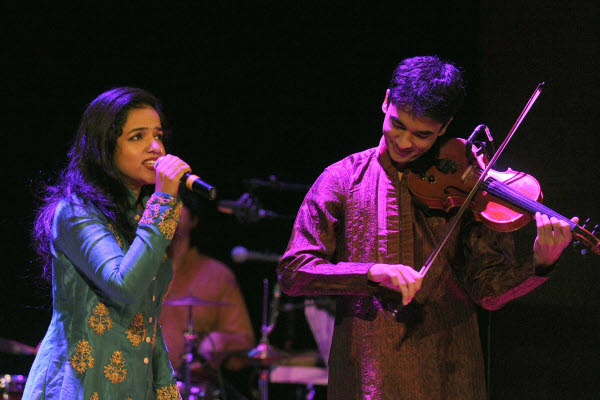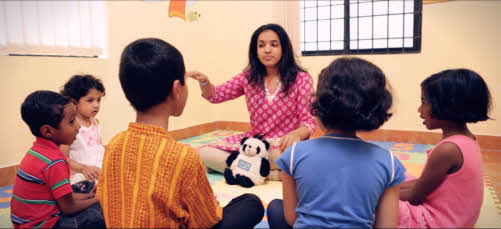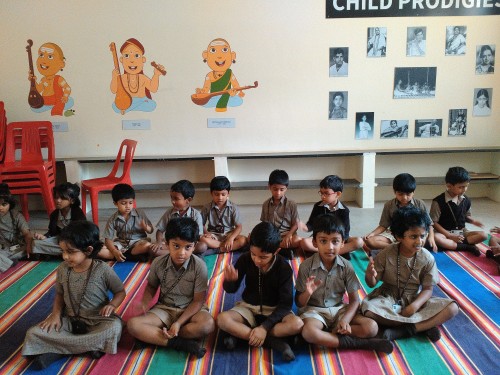Nestled amidst houses in one of the quiet streets of Sanjay Nagar, Bangalore, is a building with a modest board that hangs on its façade and reads “Subramaniam Academy of Performing Arts (SaPa)”. As you enter the premises on a warm Saturday afternoon, you hear mellifluous voices singing strings of swaras. You hear a series of notes being played repeatedly on violins by deft hands, demonstrating strenuous practice. There’s also a surprising dose of piano music that emerges gently in the background. Little kids and older children parade up and down the stairs, with their SaPa courseware and water bottles in hand while some bounce along with their violin cases strapped to their backs. There’s so much music in the air and before you realise, the musical mood catches on to you too.
Subramaniam Academy of Performing Arts, whose acronym, SaPa, interestingly, is a combination of the two notes Sa and Pa, known as the prakriti swaras, was established in 2007 by renowned violinist Dr. L. Subramaniam and singer Kavita Krishnamurti Subramaniam. While the music school’s primary focus is teaching south Indian classical music, or Carnatic music, as it’s popularly known, they also teach western classical music.
Anupama Krishnakumar interviews singer, songwriter and Dean of SaPa, Bindu Subramaniam, and violinist and Associate Dean of SaPa, Ambi Subramaniam, about SaPa’s approach to teaching music, its vision, its curriculum and SaPa’s flagship program, SaPa In Schools (SiS). Excerpts from the interview.
What is the state of Carnatic music education in India? What is SaPa seeking to contribute in this space?
Bindu: Very simply, we want to make great music fun. There are many great gurus out there, and a lot of traditional teaching methodology. We want to take forward the technique of our grandfather and the vision of our father, and engage with very young children and people who come from non-musical backgrounds. Both these groups don’t fit within the traditional structure very easily. We want to create an experience where a young child without a music pedigree can come and be provided all the tools he needs to be a great musician.
Ambi: Our aim at SaPa is to make professional musicians who learn Carnatic music in a global context. Like Bindu said, there are a number of fantastic gurus of Carnatic music out there who are taking our music forward, but sometimes we come across some wonderful young Carnatic musicians who are not aware of how to adapt their music to different audiences. We hope to teach kids in a way that they are equally comfortable performing in a sabha in the heart of Malleswaram, as well as at a world music festival in France. We try to have regular workshops at SaPa, where kids can meet both wonderful Carnatic artists (such as a workshop on percussion we recently held) and fantastic global artists (such as an Irish violin workshop). Although most of them wouldn’t become Irish violinists, the hope is that they take away even one idea from the workshop that will make them better musicians.
How have your teaching methodology and curriculum evolved since your inception? What were the driving factors behind these changes?
Bindu: I’m very inspired by the kids – the SaPa Babies. I learn so much by just watching them, and try to incorporate what I see into the methodology and syllabus. We start with a syllabus that we think will be effective based on our experience, but are open minded enough to keep tweaking it as more and more students go through it. It took me almost a year to bring out SaPa Baby Book 1 after we had a final draft of it, because I would try and get rough copies of the book into as many small hands as possible, just to see how children would react.
We wanted a design that would appeal to them and excite them, something with enough information so that they would learn a lot but at the same time, not so much that nothing would stick, and fun trivia that would make it conversational for them. Kids love saying “You know what?” and then sharing some new factoid that they’ve picked up somewhere. We wanted a book that could fit into the hands of a three-year-old and wasn’t too big or heavy but the pages should be thick enough not to tear with some rough use. In less than two years, we’ve gone through about ten thousand copies and three editions. There’s always something that we’d like to do better with each version.
Our methodology has also developed over time, as we deal with younger and younger children. I greatly enjoy watching children in diapers passionately sing nottuswarams. When children are very little, they learn in a very special way. It’s always a delicate balance to keep classical music traditional and serious enough, but still approachable enough for a small child. Music is fun, but it’s not a joke.
“I greatly enjoy watching children in diapers passionately sing nottuswarams.” – Bindu Subramaniam
For very young children, small things make a BIG difference. Making eye contact, giving a child a high-five, being encouraging, being open to all questions – these things are important. When you teach a child, you have a chance to change that child’s whole world. And in that sense, it’s important to look at yourself as a potential role model for that child. I think one thing that is different about SaPa is that we pay a lot of attention to the little things (and little people!)
Ambi: Bindu always like to talk about the babies, while I like to talk about the older ones! We’ve tried to create a syllabus that makes well-rounded performers. In many cases, when a musician goes on stage and starts performing, most of the audience may not be aware of the subtle nuances of the raga or tala that they are trying to do. The two most important things that audiences pick up is whether the music is aesthetic – beautiful tone, pitch and sense of rhythm, and whether the musicians are enjoying themselves. These are the most important things that musicians (of any age) have to keep in mind in my opinion. We try to put a strong focus on how you play and not what you play. I, as a listener, would much rather hear a simple kriti played beautifully than something very hard that sounds hard.
Another focus of ours is multi-discipline. It’s important that a violinist doesn’t just study the violin in isolation from everything else. In order to be a performing musician, you must be equipped with a variety of things. Both Bindu and I have greatly benefitted from learning different things. Learning Carnatic violin, western violin, Carnatic vocal and piano gave me different perspectives when looking at or hearing the same piece of music. It’s heartening to see a number of our kids at SaPa learning say Carnatic violin and western theory, or vocal, violin and piano. At that age, when they learn to apply the raga concept into their western piano playing, or try to figure out harmonic structures for Carnatic pieces they learn, it’s fascinating to see!
How does your curriculum encourage very young children to sustain interest in learning music?
Bindu: Very honestly, we think our primary job is to get kids to love music. If they love music, they will stick with it. Everything from our baby rooms, to the characters in the SaPa Baby Books like Baby Dikshitar and Baby Thyagaraja, to the murals on the wall and our (soft toy) baby tamburas are designed to make children love music. We have performance pieces from book 1, and we give children performance opportunities in no stress settings. For very young children, enjoying music is more important than being perfect – and the best part is, if children enjoy music, they themselves will focus more and drive themselves towards perfection. We’ve seen that with so many of our kids.
You have periodic evaluations and certification for students. At what stage/age do these begin and what is unique about this system of evaluation?
Bindu: At SaPa, we focus on creating professional musicians. When a three-year-old toddles in, we look at her as the next MS Subbulakshmi, and treat her accordingly. Students in the program have assessments at the end of each book or level, which on average can be about once a year. So children can be as young as 4 or 5 when they take their first examination. When our babies take exams, they aren’t frightened, they are excited – we try to make sure that even our certifications are fun, at least in the early stages. Exams are important because they give kids (and parents) goals, and an understanding of what is going on and where they are in the larger scheme of things. Children feel a sense of accomplishment when they finish a level and get a certificate. We want students to emerge as confident performers.
Ambi: The exams aim to test a student’s complete skills – it has technical exercises, theory, a rhythm component and performance pieces. The theory component is examined orally for very small kids while the older ones have a written exam. For exams at advanced levels, we also have presentations on Carnatic concepts. For a performer, a very important skill to have is to be able to explain and present your art form. Very often (especially when you travel abroad) musicians are asked to give workshops – some targeted to uninitiated audiences and some to professional musicians.
Tell us a bit about SaPa in Schools (SiS). What led you to start a program like this? What are the goals that you have in mind for this flagship program?
Bindu: There are so many ways that music benefits children. In most countries, music is a compulsory part of school curriculum, and even in India, on paper music education is encouraged by all school boards. However, the real situation is a bit different. Very few schools are actually able to provide quality music education to their students, for a number of reasons.
SaPa in Schools started very organically. Although we have a very limited intake at SaPa, we wanted to be able to reach out to more children, and share the knowledge we have gained. The first year, we ran a pilot with 1000 children, and now in the third year, we are rapidly approaching ten times that. The amount of support we have received for the idea has allowed SiS to become a movement.
In every school we work with, we create a SaPa Room or music environment, and students have one compulsory music period a week, which is taught by our trained facilitators. Students follow our textbooks and sit for exams at the end of the year. We provide two workshops or interactive sessions with professional musicians, so students get a chance to see musicians in action. Our syllabus is a mix of Indian music and global music. We use Indian music as a reference point for global music too. We also use global music as a way to start a conversation on different cultures, and how it’s important to understand and respect everyone. The SaPa Method uses a lot of activities and consciously shies away from using too much technology. We have collaborations with the Norwegian Concert Institute and the NMH – the main music conservatory of Norway, which have been very helpful.
We are grateful that with support we are able to provide this program free to almost 2000 children.
Our dream is to be the Akshaya Patra of music – to be able to provide high quality music education to every school going child in India, whether or not they can afford it. Through SiS, we hope to be able to give all students an idea of Indian and global music in order to ultimately make them good global citizens and tolerant humans.
How does the SiS program compare with the regular SaPa courses in terms of teaching methods and curriculum?
Bindu: We look at SaPa as a place that creates professional musicians, and SaPa in Schools as a music appreciation movement. At SaPa, the syllabus is much more rigorous and our standards are much higher. We expect a lot more from students at SaPa.
SaPa in Schools starts with a similar syllabus in level 1, but the curriculum doesn’t progress at the same pace, because the format is different. There are many more children in a class at SaPa in Schools, and it’s one period a week for children at all interest levels. We want music to be a positive force in the lives of all students, a break from everyday pressures, and an outlet for their creative instincts. We also want music to be a lens through which they view other cultures. We use music as a starting point for them to have a dialogue on social, economic, political aspects of music. We take an interdisciplinary approach and use a lot of activities to make it more suited in a prescriptive classroom environment. SaPa in Schools is a lot of fun.
We are lucky to have a passionate, dedicated set of about 25 teachers who go into schools every day and inspire thousands of children. Surprisingly, many of our teachers are doctors, lawyers, engineers, and counsellors – people who are trained in various professions, but teach music because they are passionate about it. And their conviction is a very powerful motivator for children. Our students in the SaPa in Schools program love their teachers!
Ambi: The global component in SaPa in Schools has had interesting results. We’ve had kids who have come up to us and asked us if a particular Katy Perry song was in Adi Tala!
“We’ve had kids who have come up to us and asked us if a particular Katy Perry song was in Adi Tala!” – Ambi Subramaniam
We are delighted to be working with NMH Music Conservatory from Norway – that has more than 50 years of experience teaching music to school children in Norway. They summed it up nicely – in a school of five hundred, maybe five of them will become musicians, and the rest of them will become good audiences that love music.
Through all these years of establishing, strengthening and running SaPa, what are some of the important lessons you have learnt along the way? Have any of these been incorporated in your methodology/curriculum?
Bindu: Working with so many different institutions and children has given me a broader perspective. I used to just assume that everyone knew what a djembe was, because that was within my scope of ‘normal’. We now consciously try to include things just to open up the minds of students. It could be a global music workshop, or the political context of a song. Anything that could inspire what Maslow referred to as a “peak experience”.
We’ve also learnt that so many musicians are kind and supportive and very willing to share knowledge with us and with our kids. We can all benefit from collective wisdom.
Running SaPa and SaPa in Schools has taught me to be organised and it’s added a lot of value and meaning to my life. Any day I walk into SaPa and see kids light up at the prospect of making music, I feel so grateful that I am able to play a part in it.
Ambi: The more fun it is, the more kids are going to enjoy it! Over the years, we’ve tried to make music learning more fun, while maintaining the same strive for excellence. If they don’t like what they are doing, we can never get sustained results.
Another thing we try to focus on is to enjoy performance. The classroom and practice time at home is when we sweat the small stuff. If something is not ok, we try to work a number of times to improve that, and it’s important that students start paying attention to the minor details. But come performance time, when they are on stage, it’s time to ignore all that and just go and try to have some fun!


